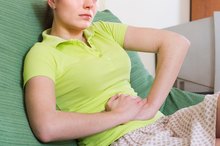How to Get Rid of Gas in Your Stomach
Stomach gas can be embarrassing, painful and an overall nuisance. Bloating, pressure, rumbling noises and stomach pains are all symptoms. Follow these tips to prevent excess gas from forming and get rid of it when it does become a problem.
Preventing and Getting Rid of Stomach Gas
Reduce your consumption of gas-causing foods, such as beans, cabbage, onions, bananas, apples and whole grains. Do not eliminate these foods all together, as they are all very healthy, but eat them in smaller quantities. Everyone reacts differently to foods, so pay attention to what may be causing your gas, and reduce those foods. Also, be sure to chew your food thoroughly and eat slowly, as this will reduce gas formation.
Foods to Avoid to Prevent Bloating
Learn More
Drink peppermint tea or take a peppermint capsule after eating. Peppermint helps expel gas from the digestive system.
Drink ginger or chamomile tea. These herbs have gas-reducing properties and help calm the digestive system. Drinking coffee after a meal may also help, because coffee stimulates stomach acid, which promotes digestion.
Foods You Can Eat to Help for Gas
Learn More
Take an over-the-counter activated charcoal capsule. Charcoal has been shown to absorb extra gas, thus reducing the amount that stays trapped in the gut. Take it to reduce gas after eating or get rid of gas once it has become painful or bothersome.
Take a probiotic supplement regularly. Probiotics replenish the good bacteria in your intestines, which are essential for good digestion. If your digestion is healthy, gas will become less problematic.
Try conventional medicines such as Gas-X or Mylanta to get rid of trapped gas. These medicines contain simethicone, which is a foaming agent that makes gas bubbles stick together so they can be expelled more easily.
Take enzyme or lactose tablets before eating. These nonprescription medicines help the body digest foods that contain lactose, which can cause gas for some people. Enzymes also aid in the digestion of many other foods that cause gas problems.
Lie on your back and bring your knees to your chest. This helps move the gas down so that it can be expelled more easily.
Tips
Try to reduce stress in your daily life, as this can be a big factor. Don't eat on the run, because eating fast makes it easy to swallow air and cause you to partially chew foods, both of which are big causes of excess gas.
Warnings
If gas is very persistent and happens regularly it may be a more serious digestive problem, and you should consult your doctor.
- Reduce your consumption of gas-causing foods, such as beans, cabbage, onions, bananas, apples and whole grains.
- Take an over-the-counter activated charcoal capsule.
- These nonprescription medicines help the body digest foods that contain lactose, which can cause gas for some people.
Related Articles
References
Tips
- Try to reduce stress in your daily life, as this can be a big factor. Don't eat on the run, because eating fast makes it easy to swallow air and cause you to partially chew foods, both of which are big causes of excess gas.
Warnings
- If gas is very persistent and happens regularly it may be a more serious digestive problem, and you should consult your doctor.
Writer Bio
Anna Sanclement has been writing fiction and nonfiction for about 10 years. In addition to writing online articles and content, Sanclement has written a novel and contributes a monthly sci-fi and astronomy column at "Around Wellington Magazine." She holds a bachelor's degree in liberal arts from Florida Atlantic University.









